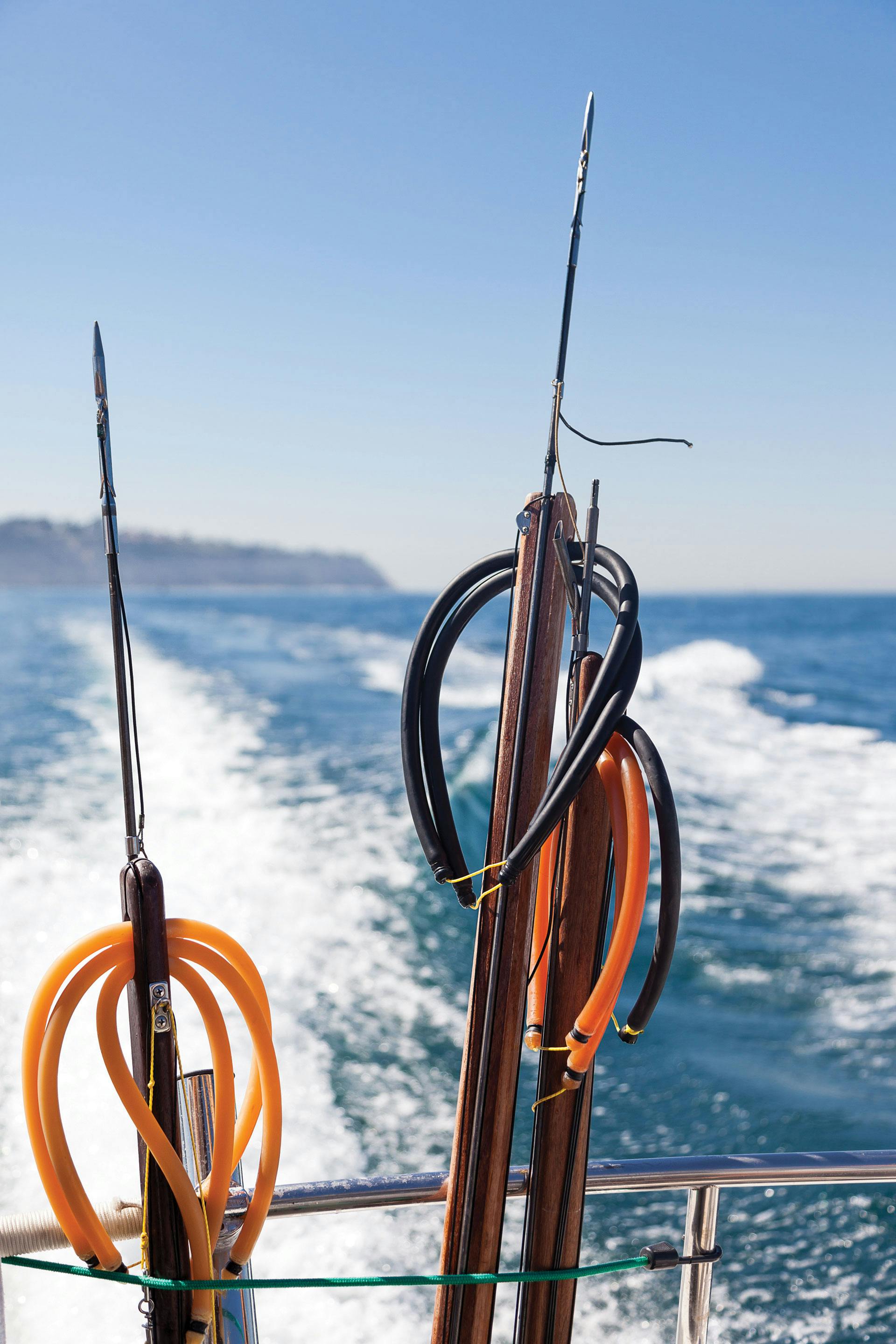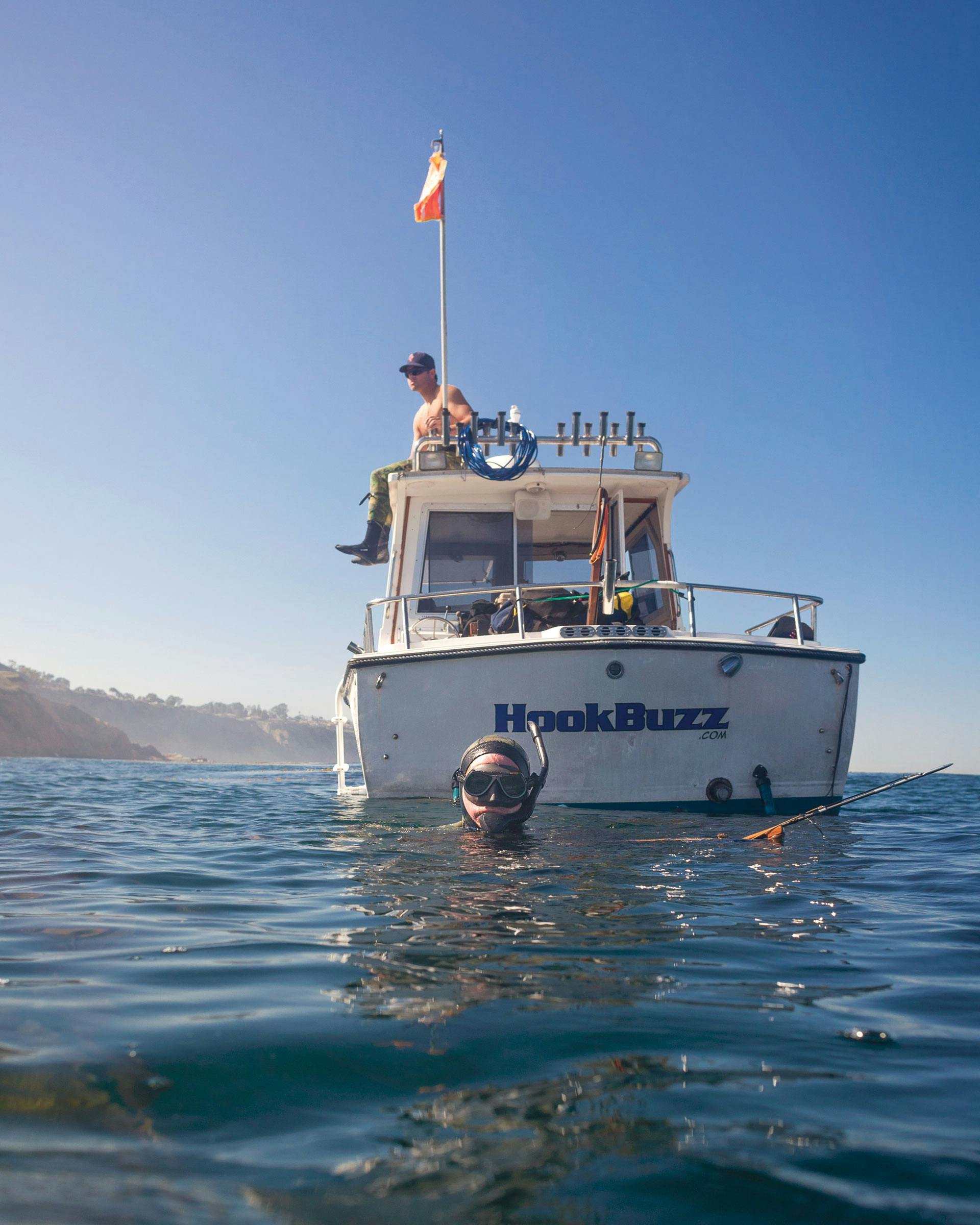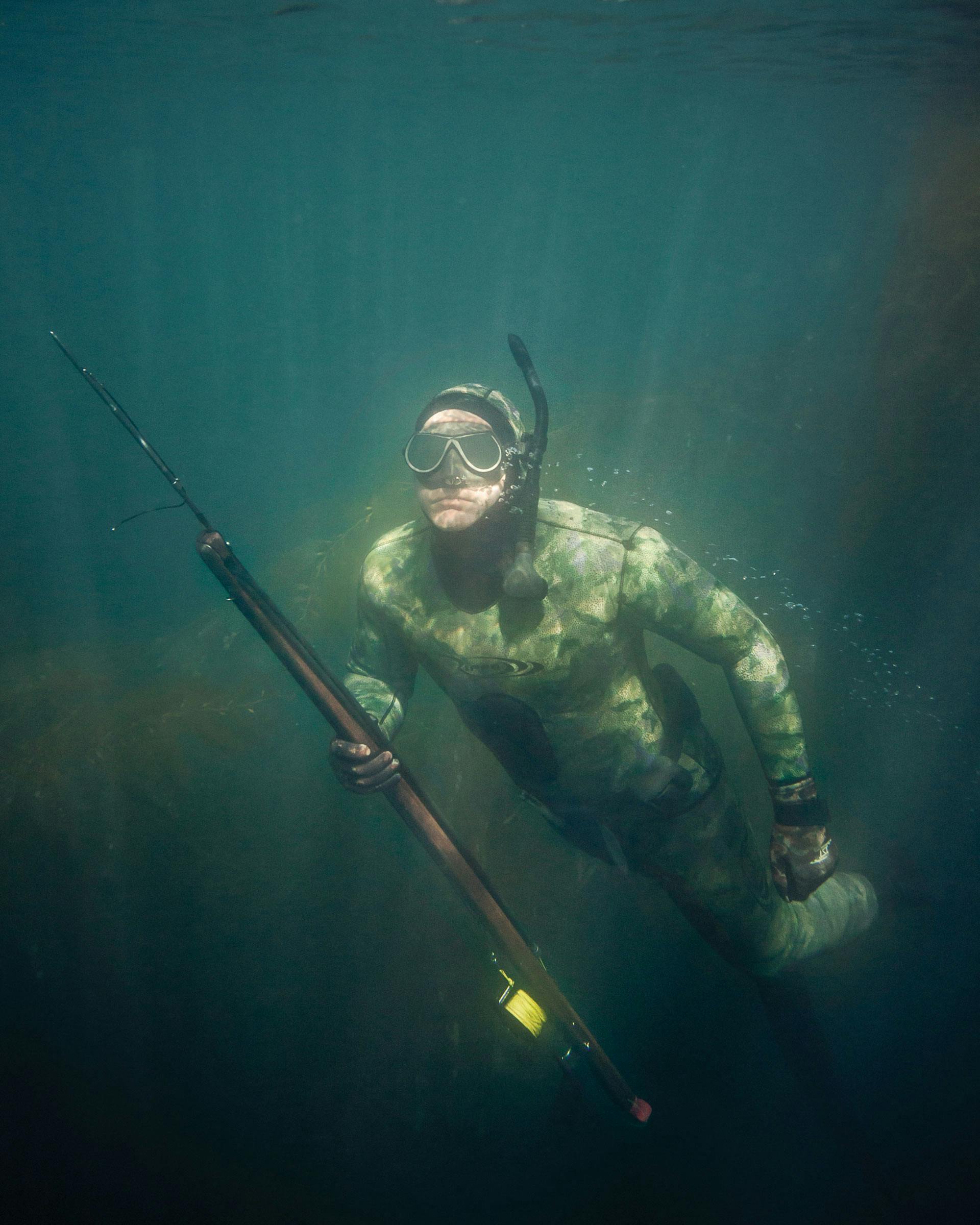Clark, the affable owner of HookBuzz.com—a spearfishing and diving company—piloted his 29-foot dive boat away from King Harbor in Redondo Beach, Calif., and toward the steep cliffs of Palos Verdes, chatting away happily about white sea bass, as ocean spray salted our clothing. The diesel engine droned on as the boat swayed; each time my stomach lurched.
The morning was crisp and cool. A layer of hazy smog sat far offshore to the starboard side, and on the port side the beach cities were only just starting their day.
Our goals were simple: If we could catch white sea bass, we would. But Clark noted that our prey, a popular sport fish that belongs to the croaker family (yes, you can actually hear them croaking underwater), is notoriously skittish. Even a burst of bubbles underwater is enough to scare the fish away. Though local spearfishermen often hunt a wide variety of local game fish, the white sea bass is highly sought after due to its taste and its elusive nature—which is why it’s one of Clark’s favorite fish to hunt.

Fish aside, our more realistic goal was to jump in and get a taste of spearfishing: donning a thick dive suit, throwing on a waist-crunching weight belt and seeing, firsthand, what it was like to free-dive down amongst the kelp forests of Palos Verdes.
We stopped the boat at the “secret spot,” one that was supposed to be in the midst of a thick kelp bed teeming with scaly ocean life. But the kelp was gone, ripped away by large surf.
“I’ve never seen it before like this,” Clark said, disappointed. We motored on to another spot and stopped. While everyone else was busy suiting up, I had a slight disagreement with my stomach off the starboard side.
Head swimming, I squeezed into my bulky, seven-millimeter dive suit and followed Clark into the water. We stayed far away from the starboard side—far, far away.
Clark swam with me to the edge of a spot of kelp, and he laid it out simply: Spearfishing is about more than hunting. It’s about experiencing the ocean and everything it has to offer.

He told me to take several deep breaths (one of the main dangers of spearfishing is blacking out from lack of oxygen) and then dive straight down, using a strand of kelp as a guideline to keep diving. The frigid water seeped into my suit and clawed along my back as I plunged down, and when I looked about I saw sunlight shimmering through blue.
Kelp rose up 20 feet from the unseen bottom, forming tree-like groves. Schools of fish, most only a few inches long, darted in and out of their shadows. Clark swam ahead of me, steady and calm, completely at home.
After swimming down a dozen feet or so, he signaled to go back up. On the surface, Clark bobbed up and down as he said that his hope—his main goal—for all this was for me to see what it was like down below. He wanted me to understand why he, his family and friends all spearfish. And I did. My stomach didn’t, even at the end of the day, but I understood.
A few weeks later, Clark and I met up at Hot’s Kitchen in Hermosa Beach. I was embarrassed about the seasick business and I apologized profusely, but Clark only brushed it off.

When it comes to the ocean and being on a boat, Clark has seen it all. He said I was actually pretty stealthy about the whole thing—I took that as a compliment.
Clark grew up in the south of Los Angeles, primarily in Palos Verdes. He says his father, Bob McNulty, was a Navy SEAL during Vietnam, and he made sure Clark and his younger brother, Kirk, spent a lot of their free time in the water.
“My dad was a big component of me getting into the water,” says Clark. They’d often sail to Avalon on Santa Catalina Island and fish for most of the weekend.
Naturally things progressed from there—the two McNulty brothers started spending even more time in the water during their high school years, occasionally spearfishing when they had the time. “We were 14 or 16, and we were getting out on our own. It was sort of fun, and we had that whole ocean environment to play in.”
Once they reached their 20s, the brothers started testing their diving skills. They swam out further and further, diving off kelp beds and going after bigger sport fish like white sea bass.
The challenge of the hunt proved immediately alluring to Clark, especially since spearfishing isn’t as easy as simply firing off a spear and snagging a fish. “You don’t see the big fish every time. You don’t just go out there and see one. They’re very skittish.”
Everything leading up to the water time also has to go smoothly. “When you pull up on a spot, you have to be quiet, drop the anchor quiet, no music. You get superstitious; you have your routines. You want to make sure you do everything responsibly too,” says Clark.
The challenges of hunting aside, Clark also makes a point of mentioning that spearfishermen have to be mindful of harvesting local fish correctly. Since he’s grown up and fished in the area throughout his life, he’s seen that most game fish—especially his preferred fish of choice—are smaller than they used to be. “Things get fished out. That’s why it’s important to drive more awareness toward the Redondo grow-out station.”

Richard Ford works as a dedicated volunteer at the Redondo Beach LA Conservation Corps’ SEA Lab, which assists with a broader, statewide white sea bass restoration project. The lab functions as a grow-out for hatchery-bred white sea bass, and every year the volunteers release the fish in the waters off Redondo to help stabilize the region’s local population.
“It’s awfully good eating,” says Rich about the sea bass. “It’s great for commercial purposes.” However, roughly half a century ago, local sea bass populations were nearly devastated because of their commercial value.
According to the California Department of Fish and Wildlife, the white sea bass population dropped dramatically through the 1950s and ‘60s, and stricter regulations had to be introduced in order to keep the bass from being overfished. “When we started killing them off, we were hurting a recreational industry. Any time you take anything out of the food chain, you’re going to have a negative impact on the ocean environment,” says Richard.
“They are a sizeable fish—excellent eating,” says Terry Maas. The avid spearfisherman, one whom Clark insisted I get in touch with, went on to mention that the fish was practically decimated locally by fishermen using controversial gill nets during the mid-20th century.
“They would use spotter planes,” says Terry. “[The white sea bass] were so thick they would change the color of the kelp bed. During the day they are very alert. At night they would go into these nets that would drown them indiscriminately.”
Increased regulations, especially those concerning the size of bass that were ready for harvesting, helped protect the waning population. “Now sea bass are becoming more prolific,” says Terry. “Now the populations are maintaining a good level.”

Furthermore, Terry adds that spearfishing is a very conservation-minded sport: The average spearfisherman sets out with a particular fish in mind, and they have to spend an exorbitant amount of effort trying to track it down. If they’re too noisy or if they miss their shots, they won’t bag their fish.
“We let a lot go,” says Terry. “Fish and Game recognizes that, and they let us dive where fishermen can’t go. We know what we’re going to get. It’s a very selective form of harvesting. We can target our species. The last thing we want to do is clean it out.”
Terry also points out that spearfishing is a valuable part of California’s history. Our state’s first watermen and women would spearfish when the surf was minimal, and they’d usually only catch what they needed—not to mention that the sheer challenge of the hunt often kept them occupied during the flat summer months.
When two contributors take the plunge with South Bay spearfishermen, they take home much more than sea bass.
 On a Sunday morning last March, 33-year-old Clark McNulty pointed at the shore as we cut through the ocean chop and said, “Having the boat is a pure breakaway from all of that.”
On a Sunday morning last March, 33-year-old Clark McNulty pointed at the shore as we cut through the ocean chop and said, “Having the boat is a pure breakaway from all of that.”
There were collective nods of agreement from the other five men on board as they tinkered with their wetsuits, weight belts and masks. I wanted to say something but couldn’t—the deck swayed, and with each dip I pleaded with my stomach to please, please not get seasick. Not now. Not here.
Clark, the affable owner of HookBuzz.com—a spearfishing and diving company—piloted his 29-foot dive boat away from King Harbor and toward the steep cliffs of Palos Verdes, chatting away happily about white sea bass, as ocean spray salted our clothing. The diesel engine droned on as the boat swayed; each time my stomach lurched.
The morning was crisp and cool. A layer of hazy smog sat far offshore to the starboard side, and on the port side the South Bay was only just starting its day.
Our goals were simple: If we could catch white sea bass, we would. But Clark noted that our prey, a popular sport fish that belongs to the croaker family (yes, you can actually hear them croaking underwater), is notoriously skittish. Even a burst of bubbles underwater is enough to scare the fish away. Though South Bay spearfishermen often hunt a wide variety of local game fish, the white sea bass is highly sought after due to its taste and its elusive nature—which is why it’s one of Clark’s favorite fish to hunt.
Fish aside, our more realistic goal was to jump in and get a taste of spearfishing: donning a thick dive suit, throwing on a waist-crunching weight belt and seeing, firsthand, what it was like to free-dive down amongst the kelp forests of Palos Verdes.
We stopped the boat at the “secret spot,” one that was supposed to be in the midst of a thick kelp bed teeming with scaly ocean life. But the kelp was gone, ripped away by large surf.
“I’ve never seen it before like this,” Clark said, disappointed. We motored on to another spot and stopped. While everyone else was busy suiting up, I had a slight disagreement with my stomach off the starboard side.
 Head swimming, I squeezed into my bulky, seven-millimeter dive suit and followed Clark into the water. We stayed far away from the starboard side—far, far away.
Head swimming, I squeezed into my bulky, seven-millimeter dive suit and followed Clark into the water. We stayed far away from the starboard side—far, far away.
Clark swam with me to the edge of a spot of kelp, and he laid it out simply: Spearfishing is about more than hunting. It’s about experiencing the ocean and everything it has to offer.
He told me to take several deep breaths (one of the main dangers of spearfishing is blacking out from lack of oxygen) and then dive straight down, using a strand of kelp as a guideline to keep diving. The frigid water seeped into my suit and clawed along my back as I plunged down, and when I looked about I saw sunlight shimmering through blue.
Kelp rose up 20 feet from the unseen bottom, forming tree-like groves. Schools of fish, most only a few inches long, darted in and out of their shadows. Clark swam ahead of me, steady and calm, completely at home.
After swimming down a dozen feet or so, he signaled to go back up. On the surface, Clark bobbed up and down as he said that his hope—his main goal—for all this was for me to see what it was like down below. He wanted me to understand why he, his family and friends all spearfish. And I did. My stomach didn’t, even at the end
of the day, but I understood.
A few weeks later, Clark and I met up at Hot’s Kitchen in Hermosa. I was embarrassed about the seasick business and I apologized profusely, but Clark only brushed it off.
 When it comes to the ocean and being on a boat, Clark has seen it all. He said I was actually pretty stealthy about the whole thing—I took that as a compliment.
When it comes to the ocean and being on a boat, Clark has seen it all. He said I was actually pretty stealthy about the whole thing—I took that as a compliment.
Clark grew up in the South Bay, primarily in Palos Verdes. He says his father, Bob McNulty, was a Navy SEAL during Vietnam, and he made sure Clark and his younger brother, Kirk, spent a lot of their free time in the water.
“My dad was a big component of me getting into the water,” says Clark. They’d often sail to Avalon on Santa Catalina Island and fish for most of the weekend.
Naturally things progressed from there—the two McNulty brothers started spending even more time in the water during their high school years, occasionally spearfishing when they had the time. “We were 14 or 16, and we were getting out on our own. It was sort of fun, and we had that whole ocean environment to play in.”
Once they reached their 20s, the brothers started testing their diving skills. They swam out further and further, diving off kelp beds and going after bigger sport fish like white sea bass.
The challenge of the hunt proved immediately alluring to Clark, especially since spearfishing isn’t as easy as simply firing off a spear and snagging a fish. “You don’t see the big fish every time. You don’t just go out there and see one. They’re very skittish.”
Everything leading up to the water time also has to go smoothly. “When you pull up on a spot, you have to be quiet, drop the anchor quiet, no music. You get superstitious; you have your routines. You want to make sure you do everything responsibly too,” says Clark.
The challenges of hunting aside, Clark also makes a point of mentioning that spearfishermen have to be mindful of harvesting local fish correctly. Since he’s grown up and fished in the area throughout his life, he’s seen that most game fish—especially his preferred fish of choice—are smaller than they used to be. “Things get fished out. That’s why it’s important to drive more awareness towards the Redondo grow-out station.”
Richard Ford works as a dedicated volunteer at the Redondo Beach LA Conservation Corps’ SEA Lab, which assists with a broader, statewide white sea bass restoration project. The lab functions as a grow-out for hatchery-bred white sea bass, and every year the volunteers release the fish in the waters off Redondo to help stabilize the region’s local population.
“It’s awfully good eating,” says Rich about the sea bass. “It’s great for commercial purposes.” However, roughly half a century ago, local sea bass populations were nearly devastated because of their commercial value.
 According to the California Department of Fish and Wildlife, the white sea bass population dropped dramatically through the 1950s and ‘60s, and stricter regulations had to be introduced in order to keep the bass from being overfished. “When we started killing them off, we were hurting a recreational industry. Any time you take anything out of the food chain, you’re going to have a negative impact on the ocean environment,” says Richard.
According to the California Department of Fish and Wildlife, the white sea bass population dropped dramatically through the 1950s and ‘60s, and stricter regulations had to be introduced in order to keep the bass from being overfished. “When we started killing them off, we were hurting a recreational industry. Any time you take anything out of the food chain, you’re going to have a negative impact on the ocean environment,” says Richard.
“They are a sizeable fish—excellent eating,” says Terry Maas. The avid spearfisherman, one whom Clark insisted I get in touch with, went on to mention that the fish was practically decimated locally by fishermen using controversial gill nets during the mid-20th century.
“They would use spotter planes,” says Terry. “[The white sea bass] were so thick they would change the color of the kelp bed. During the day they are very alert. At night they would go into these nets that would drown them indiscriminately.”
Increased regulations, especially those concerning the size of bass that were ready for harvesting, helped protect the waning population. “Now sea bass are becoming more prolific,” says Terry. “Now the populations are maintaining a good level.”
Furthermore, Terry adds that spearfishing is a very conservation-minded sport: The average spearfisherman sets out with a particular fish in mind, and they have to spend an exorbitant amount of effort trying to track it down. If they’re too noisy or if they miss their shots, they won’t bag their fish.
“We let a lot go,” says Terry. “Fish and Game recognizes that, and they let us dive where fishermen can’t go. We know what we’re going to get. It’s a very selective form of harvesting. We can target our species. The last thing we want to do is clean it out.”
Terry also points out that spearfishing is a valuable part of California’s history. Our state’s first watermen and women would spearfish when the surf was minimal, and they’d usually only catch what they needed—not to mention that the sheer challenge of the hunt often kept them occupied during the flat summer months.
 At Hot’s, Clark points out that the success ratio for snagging white sea bass is low, hovering around 10%. And while Clark enjoys the hunt and the thrill of acquiring a sizable catch, he also believes that simply being out in the ocean and experiencing its beauty firsthand is one of the main draws of spearfishing.
At Hot’s, Clark points out that the success ratio for snagging white sea bass is low, hovering around 10%. And while Clark enjoys the hunt and the thrill of acquiring a sizable catch, he also believes that simply being out in the ocean and experiencing its beauty firsthand is one of the main draws of spearfishing.
“We just appreciate the environment. And when we harvest something, we do it within the regulations, and we do it with the most respect possible,” says Clark.
Spearfishing has been an important pastime for the McNulty family, even more so in 2014. Kirk, Clark’s brother, passed on earlier this year, and Clark has made an effort to revisit the spots where he and his brother grew up fishing.
The first site we visited on our dive trip, the one that had lost its kelp forest, was one of the McNulty family’s favorite spots. “[Kirk] was a true waterman. He was the one who got me into a lot of things in
life. One of the last successful dives we had together was at that spot.”
For Clark, spearfishing is an integral part of the South Bay’s culture. It’s a part of the region’s history and highlights our connection to the ocean. Our watermen and women are not ones for wanton destruction of our ocean’s resources, but instead they find ways to harvest it respectfully while also enjoying its innate beauty.
Clark talked more about that last successful spearfishing trip with his brother, saying that Kirk managed to snag a 44-pound white sea bass. He’s glad that he has that memory of his brother and that last perfect session. “It was one of our last dives together, and it was him knocking down that quality fish. I’m so stoked we had that day.”
[tribulant_slideshow gallery_id=”41″]









